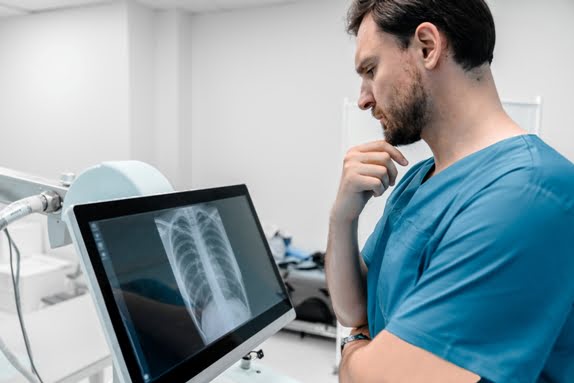Purpose of the Pelvis X-Ray (AP View)
An X-ray of the pelvis is often ordered for a variety of reasons. Some of the most common indications include:
1] Fractures: One of the primary uses of the pelvis X-ray is to assess for fractures, especially after a fall or trauma. Pelvic fractures can range from minor fractures to more serious fractures that affect the hip joint or the sacrum (the base of the spine).
2] Joint Issues: The pelvis is part of the hip joint, and an X-ray can be used to evaluate the acetabulum (the socket of the hip joint) and the femoral head (the ball of the hip). The X-ray can help identify signs of arthritis, joint degeneration, or other conditions affecting the hip joint, such as hip dysplasia.
3] Degenerative Diseases: Conditions like osteoarthritis can affect the joints in the pelvis, leading to pain and stiffness. X-rays can reveal joint space narrowing, bone spurs, or other signs of degeneration.
4] Infections or Tumors: Although X-rays are primarily used for detecting bone-related issues, they can also reveal signs of infections (like osteomyelitis) or tumors that may be affecting the pelvic bones.
5] Dislocations: In the case of trauma or an accident, an X-ray can confirm whether any dislocations have occurred in the hip joint or other pelvic joints.
6] Pre-operative Planning: X-rays may be performed as part of pre-surgical planning for hip replacement or pelvic surgery to understand the condition of the bones and joints.
If you're seeking an X-Ray Pelvis AP in Pune, Diagnopein is the best digital X-ray centre near me. This X-ray is crucial for examining the pelvis, including the hip bones, sacrum, and lower spine. It helps detect fractures, dislocations, infections, arthritis, and other conditions affecting the pelvic region. Using advanced digital X-ray technology, Diagnopein ensures high-resolution images with minimal radiation exposure. Our experienced radiologists provide accurate interpretations, helping physicians determine the best treatment plan. Whether for injury evaluation or routine screening, Diagnopein offers fast and reliable services for your pelvic health in Pune.
How the X-Ray Pelvis AP View is Performed ?
In the AP view, the patient typically lies flat on their back or stands with their pelvis positioned against the X-ray machine. The procedure involves the following steps:
1] Positioning the Patient: The patient will be asked to lie on their back on the examination table with their legs extended and feet turned inward slightly. This position helps to align the pelvis and hips in a way that gives the clearest view of the bones.
2] Taking the X-ray Image: The X-ray machine will then emit a small amount of radiation through the body to create an image of the pelvis. The image is captured by the detector on the other side of the body. The X-ray beam passes from the front (anterior) of the pelvis to the back (posterior), which is why this is called the AP view.
3] Breathing Instructions: The patient may be asked to hold their breath for a moment to avoid motion blur, ensuring a clear and sharp image.
4] Reviewing the Image: After the image is taken, the radiologist or technician will review it to ensure the pelvis is properly captured. In some cases, additional images may be needed.









